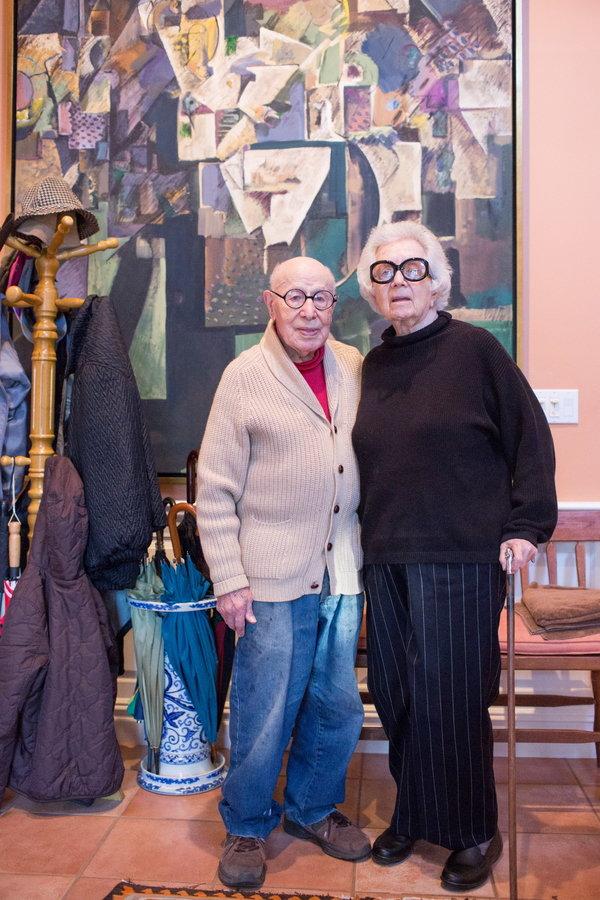In 1956, Judith Leiber, the designer who would become famous for her whimsical handbags, and her husband, Gerson Leiber, who later achieved renown as an American modernist painter, bought a six-acre property in Springs, N.Y., a hamlet of East Hampton, for $10,000.
Together they began a decades-long construction effort that would eventually include a home, an art studio, a series of formal gardens and a museum. Now, much of this creation, including the couple’s four-bedroom house, Mr. Leiber’s studio, and several landscaped gardens, is up for sale.
The property, at 464 Old Stone Highway, sits on 2.16 acres and is being offered at $3.9 million. A portion of the land is adjacent to the Leiber Collection, a brick museum that opened in 2008 to house the couple’s work. The Leibers, who had no children, were married for 72 years. They died within hours of each other from heart attacks last April. He was 96; she, 97.

Gus and Judith Leiber originally spent weekends at the house, but moved there full time a few years ago.CreditLindsay Morris for The New York Times
While the estate is selling the house, much of the Leibers’ personal effects have yet to be removed. Felt hats with jaunty feathers hang from hooks in the coat closet, bedroom shelves overflow with books, and several personal pieces, including a signed portrait of the opera star Beverly Sills, decorate the walls. The art studio, an airy, 860-square-foot space with soaring windows, appears poised for Mr. Leiber’s imminent return, with paintbrushes standing in cans and lithography stones piled in a corner.
The grounds that surround the house and art studio, designed by Mr. Leiber — known as Gus — over many years, feature brick pathways that snake around an in-ground pool, a vegetable garden, a rose garden, and a now-empty aviary. Brass pineapples decorate the gates, while sculptures and wooden structures dot the landscape.

Mr. Leiber designed the gardens, which include a vegetable garden, a rose garden and a now-empty aviary. CreditCraig Macnaughton/New York 90
“Gus would go out every weekend and work to clear the land since it was very wooded,” said Jeffrey Sussman, a friend of the couple and author of “No Mere Bagatelles,” a biography of the Leibers published in 2009. “Because of his artistic training, he became, in effect, a landscape architect.”
Mr. Leiber turned part of the land into a museum, spending $5 million on the effort, according to Mr. Sussman. “Gus had seen the works of so many fashion designers dispersed after their death, with no one place to see their body of work,” he said. “He wanted one place where people could go and see what Judy had accomplished. It was a tribute to her.”
A gate separates the Leibers’ home from the museum grounds. “They would often open the gate to let people visiting the museum walk through their personal gardens,” said Leslie T. Hillel, an associate real estate broker with Halstead. She is representing the property with Robert A. Brody and Judith E. Mendoza, licensed real estate agents also with Halstead.
As for the couple’s shingled home, it was renovated in the 1990s. Among its features are an open kitchen, a master bedroom, three guest rooms with en-suite baths, and a conservatory. The Leibers spent every weekend there and hosted regular Saturday dinner parties.
“They had a full-time cook who would prepare these stupendous dinners, and the conversation around the table was always about art or fashion,” said Mr. Sussman. The Leibers sold their apartment in New York City, a triplex on Park Avenue and 34th Street, several years before they died, and moved full time to the Hamptons.
The couple met in Budapest just after the end of World War II. The future Mrs. Leiber, then Judith Peto, was Jewish and had escaped death by sewing army uniforms; she began a small handbag business, selling them to American soldiers stationed in Hungary. Mr. Leiber, who was born in Brooklyn and grew up in Titusville, Pa., was stationed in Budapest while serving as an Army Signal Corps sergeant.
Mrs. Leiber was best known for her fanciful evening bags, often made in the shapes of animals or flowers and bedecked with intricate beading. Her fans ranged from society matrons to First Ladies, including Mamie Eisenhower and Barbara Bush.
In addition to the Leiber Collection, her handbags are also in the permanent collections of the Metropolitan Museum of Art and the Smithsonian Institution. Mr. Leiber’s paintings are in the collections of the Metropolitan Museum of Art, the National Gallery of Art in Washington and the Whitney Museum of Art, among others.
For weekly email updates on residential real estate news, sign up here. Follow us on Twitter: @nytrealestate.







